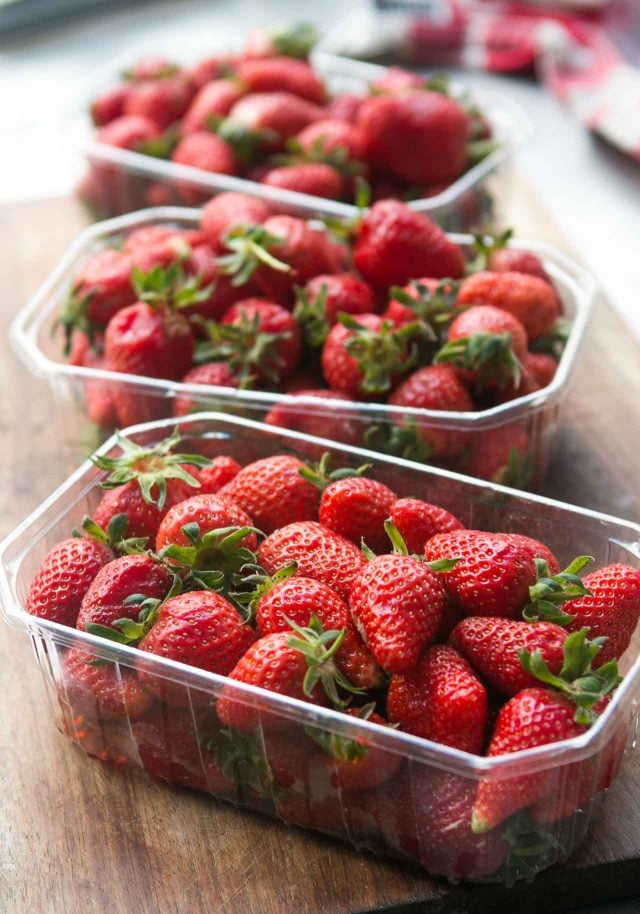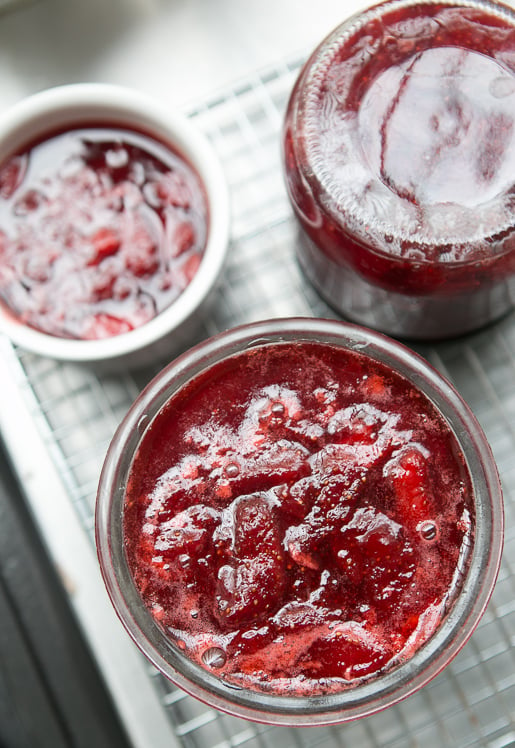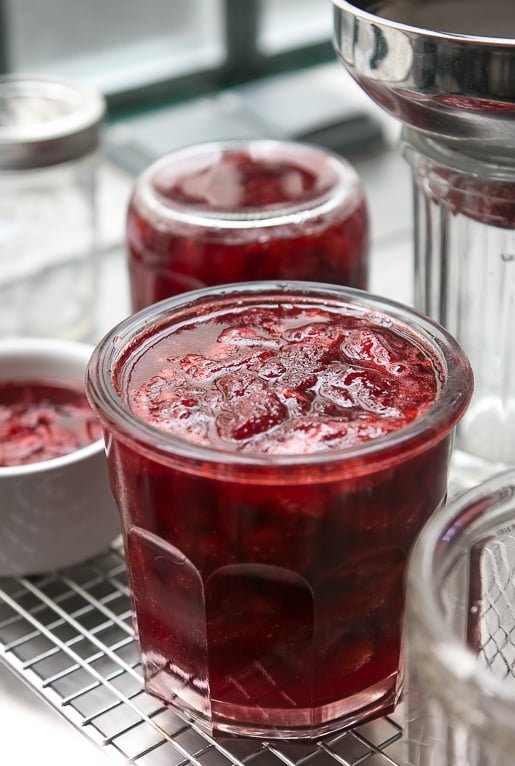I was bequeathed an overload of strawberries from the Périgord – short answer: I bought four baskets and the vendor, whose booth I shop at often, threw in two extra for free, an unspoken equivalent of a carte de fidelité in Paris – so I’ve spent the past few days washing, hulling, cutting and cooking my unexpected bounty.
I’ve been making a number of things with them. And while I was chopping and thinking (which are probably the only two activities that I’m able to do at the same time), I realized that while I have a Strawberry-Rhubarb Jam recipe on the site, I didn’t have a strawberry jam. So here it is.
Although I’m giving you a recipe for the amount of strawberries that I used, you can use the same proportions if you have just a basket, or a bushel. You’ll just need to do a slight amount of math. Only the cooking time will change, so keep an eye on things. Jam-making is not something you walk away from and you need to rely more on look and feel, rather than exact times. Another thing about jam-making is that fruit and berry jams are always better made in small batches; the shorter the cooking time, the better the flavor. So if you have more than 2-pounds (900g) of strawberries, consider making jam in a couple of batches rather than one big one.

Strawberry Jam
About 2 pints
Many traditional recipes use an equal amount of sugar to fruit, by weight, but I find it’s okay to decrease it to these proportions. Sugar is both a thickener and a preservation agent. If you reduce it too much more, your jam may not thicken and won’t keep for a long time. (Which is okay if you want thinner jam, you keep it in the refrigerator, and eat it relatively quickly.) This recipe can be scaled up or down, depending on how many strawberries you have. But if you want to make a lot more, best to make it in a couple of batches. To prepare the jars, pour boiling water into them, as well as into the lids. Let them sit 5-10 minutes, then carefully pour out the hot water and set them upside down on a cooling rack until ready to fill. Since I keep my jams in the refrigerator, I don’t put them up them in a traditional sense. I usually just overturn the jars and let them cool, which provides a reasonable seal, then refrigerate them. I find my jams keep well this way for up to one year. Check the National Center for Home Food Preservation website for instructions on how to can fruit jams. Note: Last season strawberries tend to have less natural pectin than ones that arrive earlier. So your jam may be less jelled. One strategy is the finely grate a green apple into the strawberries before cooking them, which adds pectin. (There are guidelines here for using liquid and powdered pectin.) I don’t mind the slightly runnier jam and it’s terrific on yogurt or served with fresh goat cheese for dessert.
2 pounds (900g) strawberries
1 1/4 pounds (2 2/3 cups, 580g) sugar
one lemon, organic or unsprayed
optional: kirsch (or eau-de-vie, or crème de cassis)
- Wash and hull the strawberries and cut them into quarters. If some are larger or smaller, just make sure the pieces all about the same size.
- Toss them in a large pot, such as a Dutch oven casserole made of a nonreactive material, with the sugar. Cut the lemon in half, squeeze the juice into the pot, and add the lemon halves to the berries. Stir well, cover, and let sit a couple of hours (up to 8 hours) at room temperature, stirring one or two times while they marinate.
- Put a small plate in the freezer. Turn the heat on under the strawberries to medium-high and cook the strawberries, stirring occasionally, as they reduce and the juices thicken. If a lot of foam rises to the surface, skim it away. When the syrup is the consistency of warm maple syrup – it will take about 10 to 15 minutes or so, depending on the pot and berries, turn off the heat and put a spoonful of the jam on the frozen plate and return the plate to the freezer. Check it in a few minutes; if it wrinkles when you nudge it, it’s done. If not, return the plate to the freezer and cook the jam a little more, testing it again. It may take a few times before you get it to the right consistency.
- When the strawberry jam is done, remove the lemon and stir in a few drops of kirsch, if using, then ladle the jam into the prepared jars.
In France, there is a special “jam-making sugar” that has pectin in it and a lot of people use that. I went to their recipe for confiture des fraises, which calls for equal parts sugar and fruit and checked in my Madame Saint-Ange cookbook (aka: the French “Joy of Cooking”) and she uses equal weights as well. So interesting that the woman used less, but you’re right – she likely was from a time where sugar was harder to come by.
Excellent idea !
I also love Strawberry and Thyme
Strawberry and orange peel or lemon peel
Strawberry and pepper
Strawberry and tomatoThe most difficult part is finding a Produce stand that will keep very mature tray for you, a tray that they cannot keep another day, a tray of fruits naturally full of suger, a tray that will not only be the best for jam but should also cost less… In the ” campagne” countryside, you can find such a place. In Paris even if you are loyal to a place, it is difficult
My late Mother was a world-class strawberry preserves maker. (She left the strawberries whole.). She would buy a “lug” of early summer strawberries. Preferred them for making preserves as they had more intense strawberry flavor and contained more pectin. Later crop strawberries were more sweet, softer, better for eating.
I found the lemon juice and rind addition in a book on jams and preserves published some years ago by Harrod’s in London. Their recipe also made excellent preserves.
One other thing. I too do not process my jams, but store them in the fridge. I put the jars into a pot where they’ll be covered with boiling water, let them simmer for 10 minutes, tossing in the lids (rings) and caps at the last minute. I turn off the heat and leave all in the hot water until I fill.
Big tongs are important. I pull the jars out singly as I am filling them, draining any water out. Hot jars dry themselves almost instantly. Another tool I couldn’t do without is a funnel thingy with a big opening, intended for filling jam jars. Mine is plastic. This is important because in order to get a good seal the rims of the jars must be pristine and dry. Not a trace of jam or syrup. I leave the filled and capped jars sitting upright on a towel. As they cool you can hear the lid caps pop as they seal.
I also keep mine refrigerated. Boil glass container and lid before pouring the very hot jam to the top. Then turn them upside down till they cool down. And then in the refrigerator where they keep quite long.
I put as little sugar as possible.
Use either special Jam sugar or brown sugar or muscovado and always lemon juice.Hello Emily, yes whatever fruit I use I always “marinate” So the sugar gets soaked with the flavors. Especially if I add some other flavors ( such as pepper, orange, thyme) or white peaches + Verbena The flavors have to blend before cooking.
Good stuff deserves some time doesn’t it ?
I have lived in Upstate NY and red fruits on pancakes, in triffles, on Vanilla ice cream or lemon sherbet …
Bon appétit et bonnes confituresI too try to use less sugar. Letting the fruit macerate first helps the sweetness of the fruit deepen. I always make sure the berries are dry and free of water (from rinsing), before using. I can mine for longevity (some for gifts). Orange is a great flavor enhancer for strawberry!
I’m feeling the taste just from your yummy pictures…. My personal experience of ‘the best’ confiture is a ‘raw strawberry preserve’. I add just a small amount of really ripe & beautifully fragrant strawberries into my ‘mixer’, together with some sucre gélifiant (which I usually bring from Switzerland as I had trouble of finding anything adequate in Paris), I add a dash of cinnamon, some fresh lemon juice, and – if the devil rides me – a tiny amount of Kirsch, put the mixer on and allez-hop, in small jars, and in the fridge. No problem to keep because usually they just about make it to the next day or one after….
Love that you lessen the amount of sugar, and love that you established such a great contact with your seller :)Please let me know when your next trips are. I want to go! Merci beaucoup!!!
My Father taught me the 3+3 = 5 recipe. Works very well for true berry fruit, but also for a strawberry plus result (strawberries alone need added pectin in this case). The above equation is raw ingredients to final product. But these days I manage pretty well without weighing, I do it by the look of the mixture before bottling. Too little sugar, it goes off. Too much, the sugar recrystalises and you feel it by a “crunch” in eating the jam.
I really hate the plate in the freezer test. I’d rather have a temperature to read on the candy thermometer. And I always can by the boiling water method. Who has enough refrigerator space to keep jellies in there?
I do :-) 2 shelves are dedicated in Autumn. 1 for Summer berries, apricots, peaches and another one for figs, plums, and starting apples and pears…
I have a big fridg on purpose .
I only wish my fridge was big enough to store jam in, it’s full of a million jars as it is! Thank you, David, for your explanation that a shorter cooking time gives a better flavour. I knew that a smaller batch is supposed to be better (I usually do mine in the microwave) but I’ve never known why.
i still have some of my strawberry jam from last year on the shelf, but this looks so much brighter! with the lemon and all. i’ll be coming into some strawberries very soon here if all goes according to plan, so can’t wait to jam it up with this recipe!



I was taught to make jam 45 years ago by a then elderly French woman who had, of course, learned from her grandmother, who in turn learned…well you know. Rather than skimming the foam off the cooking jam, she had me stir in a small amount of unsalted butter. Maybe a tablespoon for the amount you describe. The foam disappears. The taste of the jam is not altered. The sugar to fruit ratio I was told to use is 1/3 sugar to fruit. Oh course she learned to cook during the war when sugar was not available, but the jam was sweet.